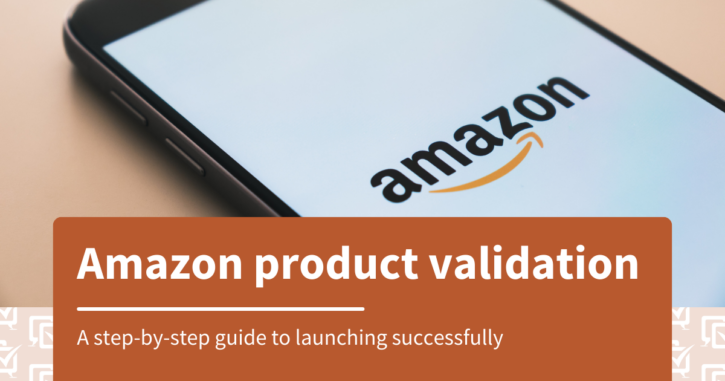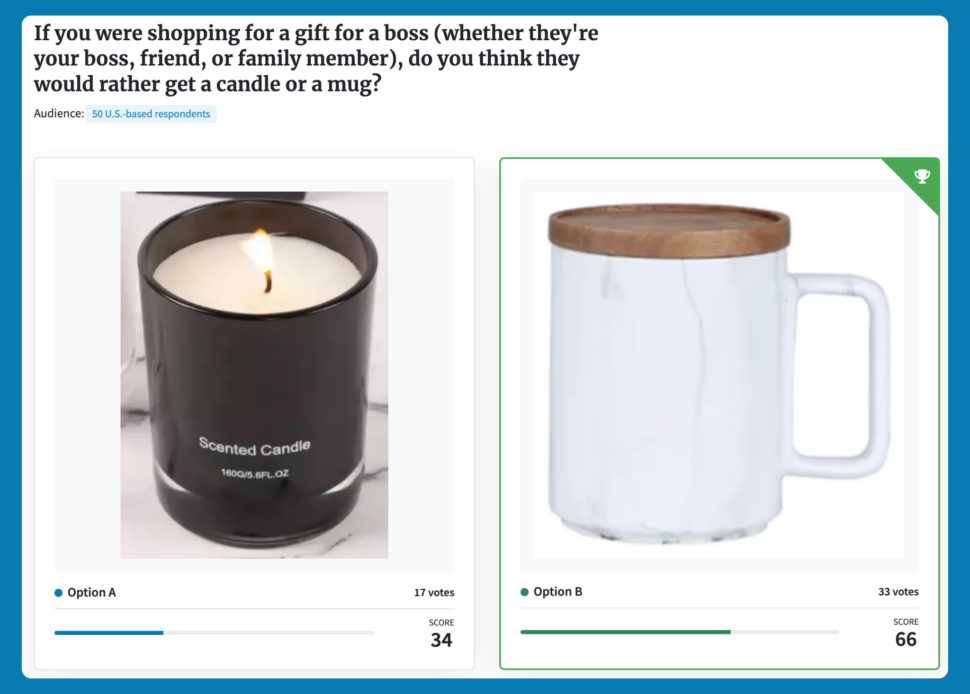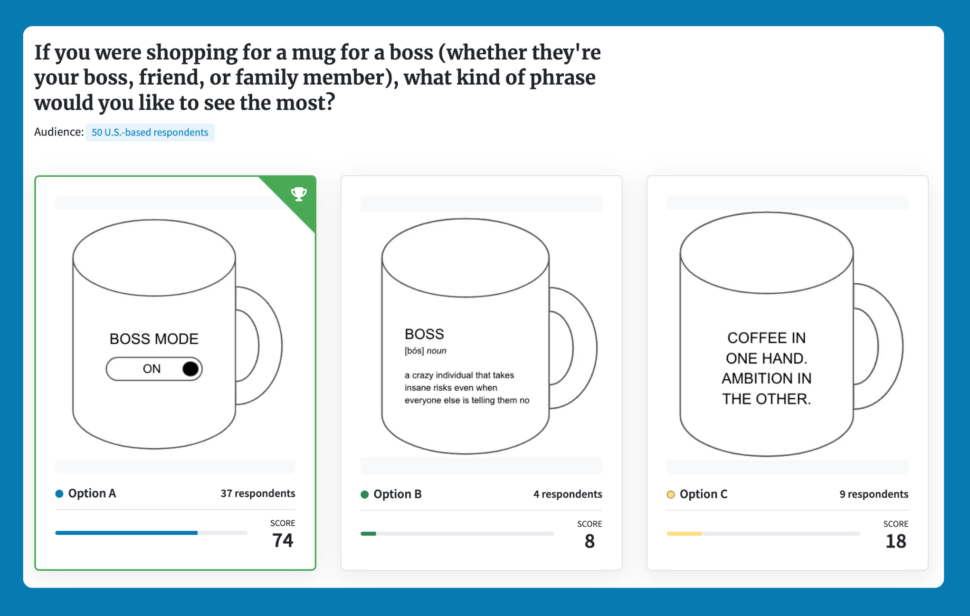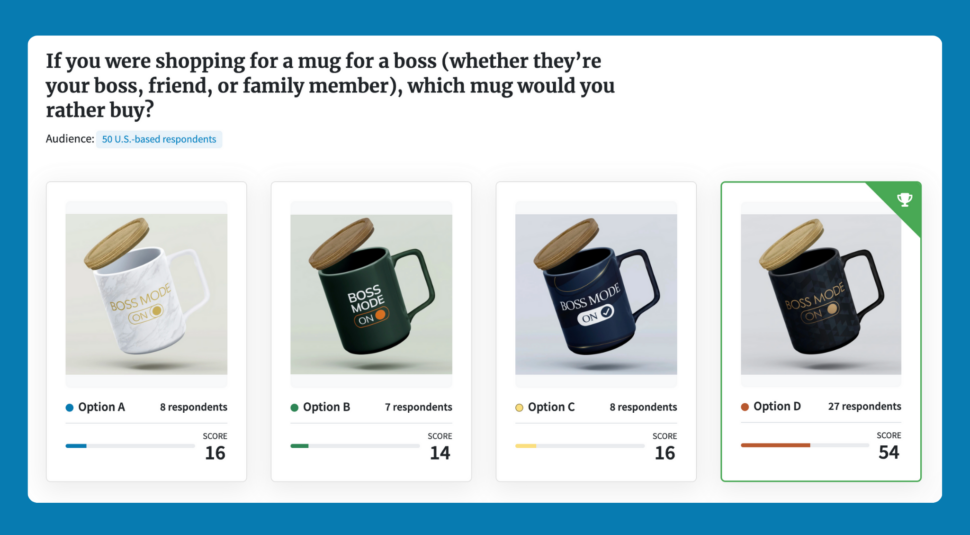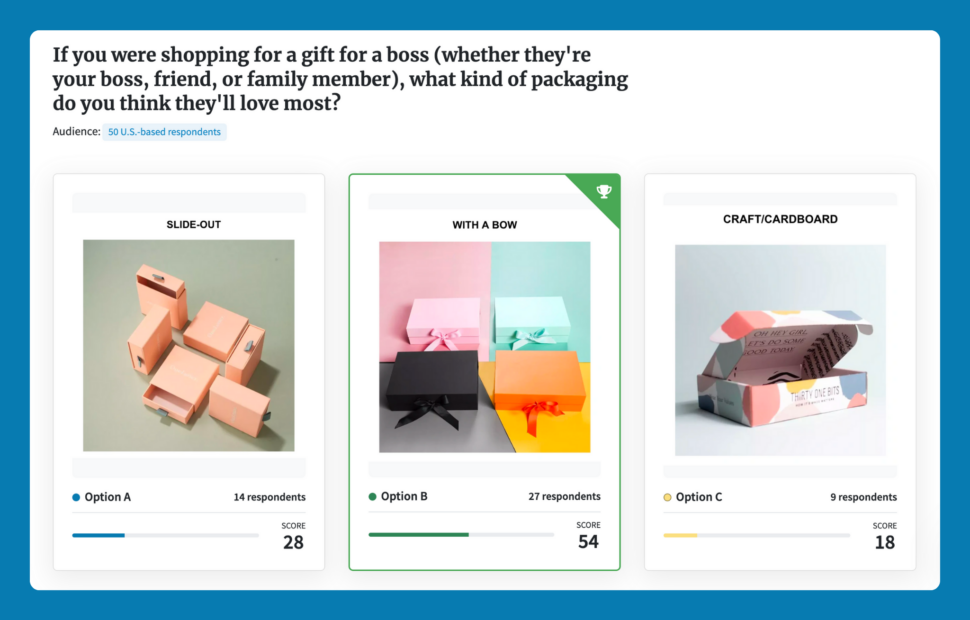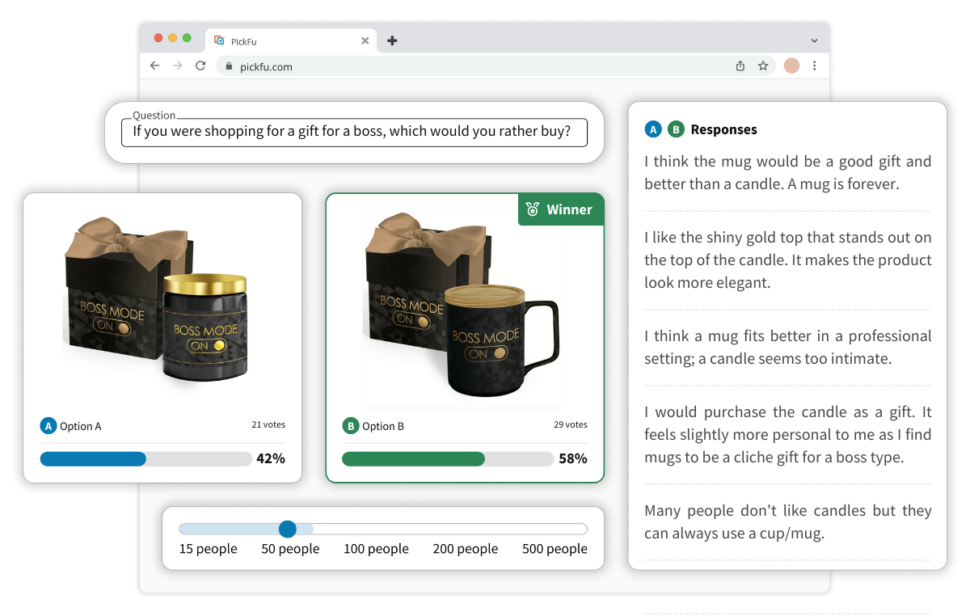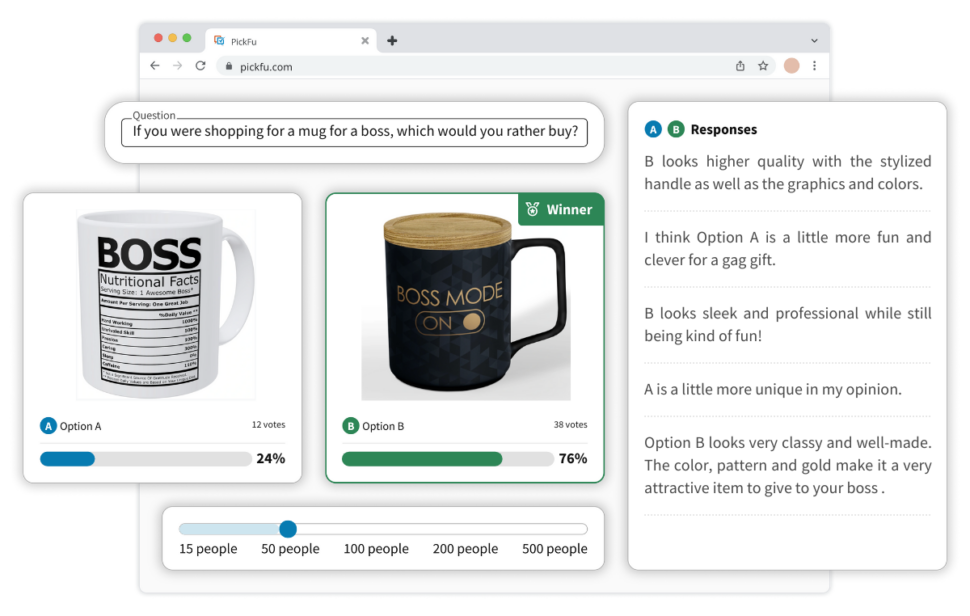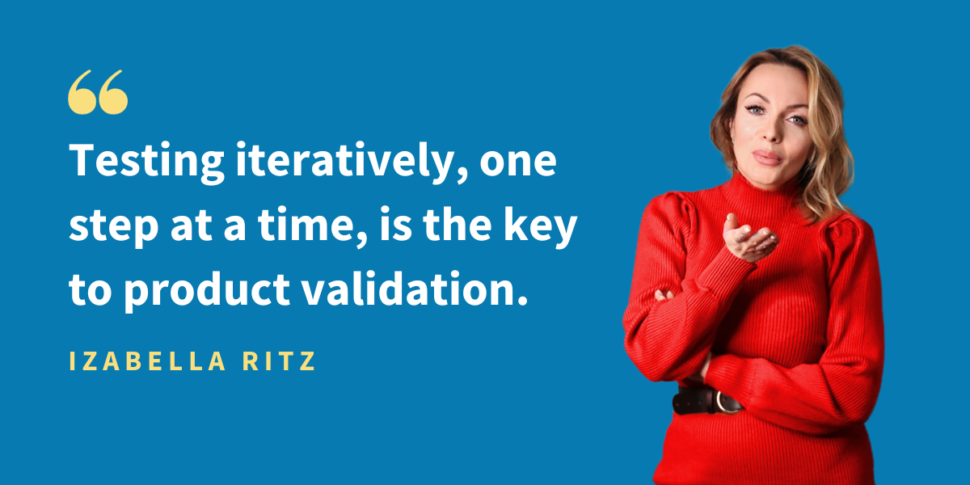If you’re selling products on Amazon, you already know that it’s more competitive than ever. Standing out from the crowd of similar products to capture and keep shoppers’ attention is, quite simply, hard. Adding to the challenge is the fact that many e-commerce sellers don’t actually know whether their products will appeal to buyers at all – meaning lots of time and money gets wasted before they even launch.
Don’t gamble when launching new products on Amazon. Putting in the effort up front to research, test, and validate your products before you launch, using data to drive your decisions, gives you a much better chance of competing successfully.
At Ritz Momentum, I help clients validate their Amazon products by using PickFu throughout the research, testing, and optimization process. PickFu is a polling platform where you can ask your target audience for their preferences and feedback on your products. This approach helps sellers build what customers actually want and reduce their risk when launching new products.
In this post, I’ll walk you through my proven step-by-step guide for Amazon product validation, sharing tips on how to split test your concepts and designs with PickFu. Let’s get started!
Step 1: Conduct market, product, and competitor research
A common mistake that e-commerce sellers make is coming up with a product idea themselves and then trying to sell it. You should actually do the opposite: find an opportunity in your market (a gap that you can fill, extra demand for a product, etc.) and then create and sell that.
The specific area or product you look into will depend on your knowledge and expertise in the market, your investment budget, and other factors, but this approach makes much more sense than just guessing what your target audience wants.
Once you’ve narrowed down an idea for your product, it’s time to dive into product and competitor research. Test out different keywords to see which products and brands appear. Look at your main competitors that keep popping up high in the search results:
- What do their images look like?
- How are they writing their product descriptions?
- What are their customers saying in reviews?
All of this is valuable information as you begin planning your own product.
The example products we’ll use in this guide are mugs and candles for a boss/entrepreneur. In our market research, we found that the two most common gifts for bosses were mugs and candles, so we decided to design and test both options.
During this phase, choose a few of your top competitor products and test them against each other using PickFu to see what people like or dislike about them. Combined with information from Amazon reviews, these tests can provide inspiration for what to include (or avoid) when designing your own products.
Step 2: Split test your product concepts and designs
Next, you need to narrow down your product designs to find the ones that people are most likely to buy. Come up with multiple variations of your product and test them against each other, making small changes based on feedback until you have a winner.
Testing iteratively, one step at a time, is the key to product validation – for example, we tested phrases and design options first, then the product shape and color, then the packaging. These iterative tests ensure you get specific audience feedback to create the best product possible.
For the mugs, we came up with five phrases to test. We ran a poll in PickFu, again targeting 100 Amazon Prime members, with the question: “If you were shopping for a mug for a boss (whether they’re your boss, friend, or family member), what kind of phrase would you like to see the most?”
In the first poll, we tested three of the phrases against each other, which gave us a clear winner with 72 votes. Then we tested the winning design against the other two phrases. The same design won again with 74 votes.
Next, we did the same thing with mug shapes, testing our concepts against each other over three polls until we found our winning design. Then we added the winning phrase to the winning mug shape, testing various colors, fonts, etc.
Finally, we tested our product packaging and found a winning box design. (Don’t neglect this piece – your packaging matters and can help increase your conversions!)
After repeating this same process for the candles, we tested the final mug design against the final candle design and asked our panel which one they would rather buy as a gift for a boss. The results were close enough (58 to 42) that we decided to launch with both products.
Step 3: Test the winning product design against your competitors
It’s not time to celebrate yet. Testing your own designs against each other is one thing – but testing them against the competition (and winning) is how you’ll launch successfully.
Choose your top few competitors from your initial market research, build a poll that tests your product against theirs, and ask respondents which one they prefer. If they prefer your competition, make iterations to your product design based on their feedback. Keep iterating and testing until your product wins.
During this phase, it’s extra helpful to analyze the poll responses you get. In PickFu, you can break down responses by demographic and read respondents’ written feedback. Your audience will often share helpful insights about why they liked or didn’t like something, which you can use to optimize your product. You can also watch for outliers in the data – for example, if someone gave you a low rating compared to the majority, but they didn’t end up being relevant to your target audience or use case.
Congratulations! Now you can launch on Amazon with much lower risk, since you’ve proven that a segment of your target audience prefers your product over the competition.
Step 4: Finalize and launch your validated product!
Typically for my final test of the optimized product, I’ll run an Open-Ended poll where I ask the audience what they think about the product overall and give it a rating from one to five stars. Feel free to run even more polls, if your time and budget allows.
Remember, the Amazon product validation process is about making data-driven decisions to reduce risk and ensure customers will love your product. This is the best way to avoid losing out on sales later.
You’re ready to launch confidently! 🎉
Tips for running effective polls
Here are a few of my tips for running effective polls in PickFu:
Make sure your poll questions are specific and give your panel the right context. For example, don’t just ask “Which mug do you like better?” if you really want to know “If you were buying a mug as a gift for a boss or entrepreneur, which design would you choose?”
Choose the right poll type. In PickFu, you can choose between several poll types. During our Amazon market validation process, we most often use Head-to-Head, Ranked, or Open-Ended / Star Rating polls.
- Head-to-Head polls test two options against each other. The audience chooses which one they prefer.
- Ranked polls allow you to test 3-8 options against each other. This helps you narrow down multiple variations of your product.
- Open-Ended polls let you ask your audience a question, and they submit a free-form written answer. You also have the option to include a Star Rating, where you ask the audience to rank your product or design from one to five stars.
Target your potential customers. When selecting your panel in PickFu, you can choose between 15-500 respondents to answer your poll. I recommend asking at least 50 people to ensure you get enough data. From there, you have a lot of options for narrowing down your specific audience:
- By country: target respondents in the U.S., Canada, U.K., Germany, or Australia.
- Random or targeted: you can choose a random pool of respondents (all of whom are vetted by PickFu and paid for their time, so you get high-quality feedback) or choose from 90+ targeting traits to narrow down your audience further. I’ll typically select “Amazon Prime members” as a trait when testing Amazon products.
- Don’t go too narrow! Make sure you’re not potentially excluding anyone who could buy your product. For many tests, broader is better.
Continue to optimize your products and listings
Your work isn’t completely done once you launch. To maximize conversions and sales, you should also consider optimizing other elements of your Amazon listing, such as your main image and product description. After all, it’s not enough to have the best product – you also have to attract and keep your audience’s attention with a great listing.
It’s possible to double your sales if you double your click-through rates by optimizing your main image, product titles, etc. with the help of market research and consumer feedback data.
You can use a very similar process to optimize your listing as you did when validating product concepts: by running polls with your target audience in PickFu. It’s free to sign up, polls are cost-effective, and you’ll start receiving high-quality feedback within minutes after launching. Sign up for PickFu to start validating and optimizing your products.
Need help with this process? Ritz Momentum is a PickFu-certified agency and can help you validate, design, and launch your next Amazon product successfully. You can learn more and connect with Ritz Momentum here.
